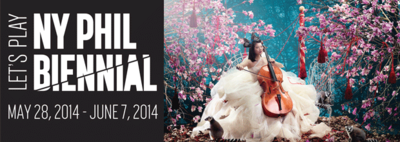Alex Ross's Blog, page 170
June 2, 2013
Levine returns, Gilbert expands
The Bungert renaissance
A-AW8: The higher crossover
In the past decade or two, we've seen a significant wave of pop-based musicians who've taken a deep interest in twentieth-century classical composition. Radiohead, Björk, and Joanna Newsom come immediately to mind. Here are two younger examples, who otherwise don't have much in common: Holly Herndon, a fast-rising electronic artist who studied at Mills College and names Galina Ustvolskaya and Maryanne Amacher as major influences: and Dywane Thomas, Jr., aka MonoNeon, a Memphis-born bass-guitarist and composer who draws on the microtonal tradition. (See also "Memphis Jookin with Microtones" and "Julián Carrillo in a Memphis Juke Joint.") I like a sentence in the MonoNeon Art Manifesto: "Have the southern soul/blues and funk at the bottom and the experimental/avant-garde at the top." And they say all the possibilities are exhausted....
This concludes Anti-Anniversary Week; for prior installments, read down.
June 1, 2013
A-AW6: Jennifer Walshe
The Dublin-born composer, vocalist, and conceptual artist performing at Electric Eclectics, in Meaford, Ontario, in 2008.
May 30, 2013
A-AW5: Tristan Perich
When I attended La Monte Young's Trio at his Dream House in 2005, I sat between Perich and John Luther Adams. I realized this only later, not knowing either of them at the time.
May 29, 2013
NY Phil Biennial
The New York Philharmonic has found a splendid way to mark the anniversary of the Rite. No, they're not playing the piece; rather, they have announced details of the new-music Biennial, to be held in late May and early June, 2014. In a culture saturated in nostalgia for a nineteenth-century past, the Rite signalled that new visions were not only possible but essential: it commenced a reordering of the repertory and of the very mindset of the classical orchestra. I can think of no finer tribute to the spirit of the work than to focus relentlessly on the new — and the Philharmonic, to its credit, is doing so.
The main events are these: 1) an Alan Gilbert-led program that includes the world première of Christopher Rouse's Fourth Symphony, the local première of Peter Eötvös's DoReMi, and two works culled from a "national open call for scores"; 2) a Matthias Pintscher-led program with Elliott Carter's final work (Instances), another open-call score, and Pintscher's own Reflections on Narcissus; 3) a Bang on the Can collaboration, featuring Julia Wolfe's Anthracite Fields and Steven Mackey's Dreamhouse; 4) a CONTACT! program at the Museum of Modern Art, duplicating Pintscher's Beyond Recall project, which will have its début in Salzburg this August; 5) a second CONTACT!, at the new SubCulture venue, featuring solo works by younger Americans (Oscar Bettison, Ryan Brown, Michael Hersch, Chris Kapica, Eric Nathan, Paola Prestini); 6) an Orchestra of St. Luke's event centered on the influence of Pierre Boulez, with works of Holliger, Mantovani, Dalbavie, and Manoury; 7) a second St. Luke's concert, this one centered on George Benjamin, with works of Colin Matthews, Helen Grime, and Ryan Wigglesworth; 8) a staged production of HK Gruber's Gloria—a pigtale; 9) a Gotham Chamber Opera Poe double-bill of Toshio Hosokawa's The Raven and André Caplet's Conte fantastique; 10) a Marino Fromenti recital, centered on contemporary echoes of Liszt; 11) the American Composers Orchestra Underwood New Music Readings, now under the Biennial umbrella; 12) a Special Music High School / Face the Music program focusing on very young composers, alongside Vijay Iyer and Huang Ruo; and 13) and another event focused on elementary and middle-school composers.
What I like about this undertaking — the Philharmonic's most ambitious effort on behalf of new music since Jacob Druckman's Horizons festivals of the 1980s — is its concentrated time-frame. It has the potential to break out of the classical ghetto and into the consciousness of cultured New Yorkers. While there are a fair number of familiar names in the programs, the open-call scheme creates an opportunity for real discoveries. I also like the interlacing of European and American new-music worlds, which too often stand apart, and the collaborative atmosphere, with various institutions large and small (Lincoln Center, Juilliard, MoMA, the Met Museum, the 92nd St. Y, St. Luke's, Gotham, Bang on a Can, the ACO, the Kaufman Center) brought into the mix. Women are underrepresented, but they are not invisible. In all, this is a significant step forward for the orchestra.
A-AW3: Stefan Prins
For the third installment of Anti-Anniversary Week (explanation here), I'm reposting Stefan Prins's Generation Kill, which I encountered at the 2012 Donaueschingen Festival and chose as one of my events of the year. It's a musical meditation on video-game technology, social media, and drone warfare, in which live performers undergo instant manipulation by way of Playstation devices. "Meditation" is, in fact, not quite the right word; this is a work of fierce, unsettling tension, one that got under the skin even of a seen-it-all German new-music audience. Performing above are members of the Nadar Ensemble, with the composer himself (far right) supervising the sound mix.
May 28, 2013
Anti-anniversary week (2)
Anna Þorvaldsdóttir's Streaming Arhythmia, from her 2011 CD Rhízōma. As noted below, Anna will be featured in a Miller Theatre Composer Portrait next season.
Alex Ross's Blog
- Alex Ross's profile
- 425 followers




